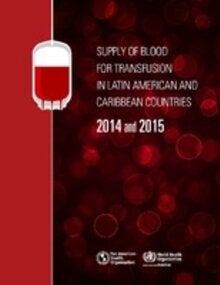This document follows up the publication “Supply of Blood for Transfusion in Latin American and Caribbean Countries 2012 and 2013” and presents indicators on the availability, safety, and use of blood and blood components, as well as the organization of national blood systems. It is based on data provided by the health authorities for years 2014 and 2015. In the Caribbean, 18 countries/territories responded for both 2014 and 2015 and in Latin America, 17 for 2014 and 18 for 2015.
Standard Excel reporting forms were sent to the countries for the collection of statistical data, which on receipt, were analyzed and consolidated for this publication. In 2013, the Pan American Health Organization (PAHO) and World Health Organization (WHO) jointly made changes to the form to coordinate the regional indicators collected by PAHO with the global indicators collected by WHO, facilitating reporting by the national authorities through a single form. The new form also requested information on haemovigilance, apheresis procedures, plasma derivatives, disaggregated blood donor data, transfused patients, and the discarding of blood units.
Some of the additional data are used to monitor and periodically report to the Governing Bodies on progress and challenges in implementing the PLAN OF ACTION FOR UNIVERSAL ACCESS TO SAFE BLOOD 2014-2019, approved by the 53rd Directing Council in October 2014 (CD53/6). The plan has four strategic lines of action:
- Effective and sustainable integration of national blood programs and services into the national health system to achieve blood self-sufficiency, safety, efficiency, availability, and universal access to blood and blood components;
- Self-sufficiency in safe blood and blood components through 100% voluntary non-remunerated donations;
- Quality management in the national blood system and screening for transfusion transmitted infections;
- Health surveillance, haemovigilance, risk management, monitoring, and evaluation.
We hope that this publication will continue to serve as a reference for national authorities, professionals working in this field, and other individuals and institutions interested in developing and organizing the blood systems of countries/territories in the Region of the Americas.
|

